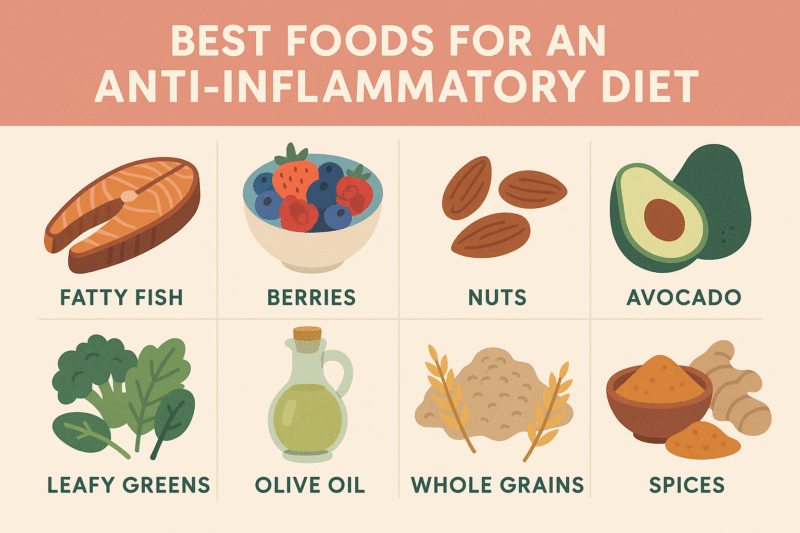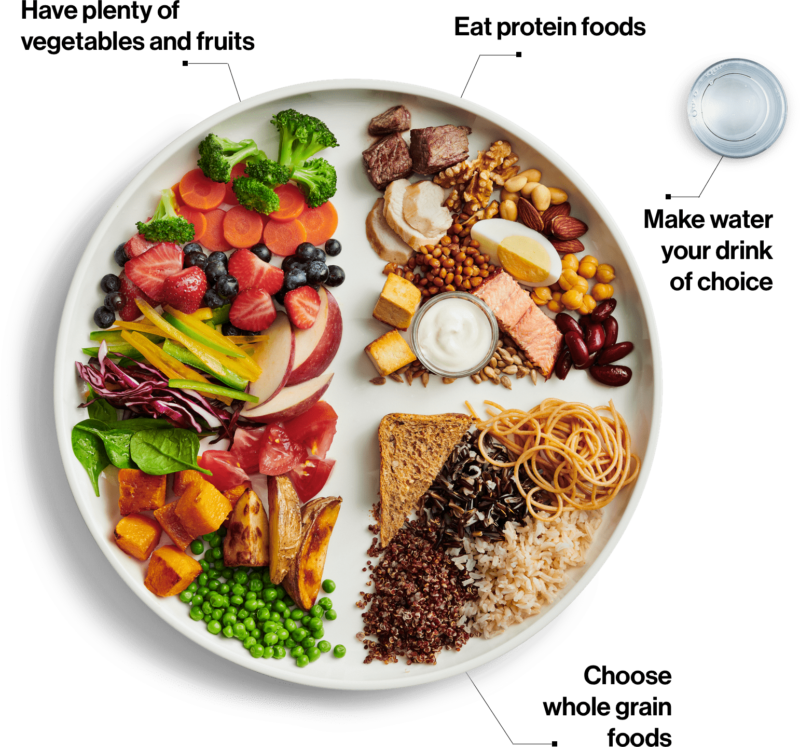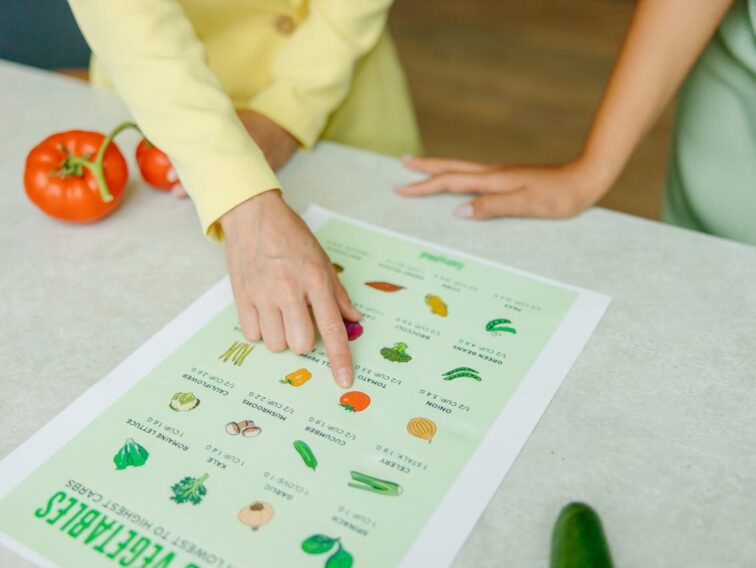Chronic inflammation can make everyday life a challenge, causing lingering joint stiffness, pain, swelling and fatigue. Over time, this smoldering inflammation may also contribute to serious conditions like arthritis, heart disease or diabetes. The good news is that nutrition can help. Experts recommend a “rainbow” of fruits, vegetables, whole grains and legumes. These foods that fight inflammation are rich in anti-inflammatory nutrients to help your body calm down its immune response. Choose the right foods, limit processed foods and you can gradually reduce inflammation and feel better over time.
How Diet Calms Inflammation
Research shows that an anti-inflammatory eating pattern can translate into real symptom relief. For example, people adopting this style of eating often see “decreased muscle or joint pain” and “decreased swelling in your hands and feet”(1). That’s because many anti-inflammatory foods contain compounds that literally dial down inflammation in the body. Fatty fish like salmon or tuna are rich in omega-3 fatty acids – ingredients proven to reduce inflammation. Similarly, the Mediterranean diet (high in fruits, vegetables, whole grains, fish and olive oil) has long been shown to lower inflammatory markers. Over years of healthy eating, even serious flare-ups can be prevented. One large study found an anti-inflammatory diet helped cut the risk of gout by up to 60%. It also helped ease osteoarthritis pain. In practice, people often report not only less pain but also more energy as their inflammation subsides. Small changes added up over a few months can make a big difference.
Key Anti-Inflammatory Foods
Here are some top foods to include in your diet. All of the following have been linked to lower inflammation:

Produce
- Leafy greens: Spinach, kale, collards and other dark-green vegetables are high in vitamins, minerals and plant compounds. Harvard experts list green leafy vegetables as cornerstone anti-inflammatory foods. Their antioxidants help protect cells from inflammatory damage.
- Berries: Blueberries, strawberries, cherries and other brightly coloured berries contain anthocyanins and other antioxidants. These compounds have well-documented anti-inflammatory effects, helping to reduce chronic inflammation and protect against disease.
Proteins
- Fatty fish: Salmon, tuna, sardines and mackerel provide omega-3 fats that “reduce inflammation”. Studies show regular intake of these oily fish can ease joint pain and stiffness.
- Nuts and seeds: Almonds, walnuts, pistachios and similar nuts pack healthy fats, fiber and vitamin E. Multiple studies confirm that people who eat nuts regularly have lower levels of inflammatory markers. For example, one long-term study found that those eating the most nuts had about a 50% lower risk of dying from inflammatory disease than those eating the least.
Fats
- Extra-virgin olive oil: This healthy oil is loaded with monounsaturated fats and a natural anti-inflammatory ingredient called oleocanthal. Oleocanthal works much like a mild, natural NSAID to block inflammatory enzymes. (Mayo Clinic even suggests swapping lard or margarine for olive oil.)
- Avocado: Creamy and versatile, avocados are rich in monounsaturated fat, potassium, magnesium and fiber. In one study, adults with a high BMI who ate avocados daily for 12 weeks showed significant drops in inflammation markers (like IL‑1β and CRP) compared to those who didn’t.
Grains
- Whole grains: Foods like brown rice, oats, quinoa and barley are high in fiber. Fiber-rich whole grains help lower C‑reactive protein (CRP), a key marker of inflammation in the blood. Swapping refined grains (like white rice) for whole grains is an easy way to cut inflammation.
Other
- Spices: The best anti-inflammatory spices are turmeric and ginger. Turmeric’s active ingredient curcumin is a powerful anti-inflammatory compound. It has been shown to ease inflammation in arthritis, diabetes and other conditions. Ginger also contains natural anti-inflammatory chemicals. In fact, a controlled trial found that a ginger-turmeric supplement was as effective as the arthritis drug naproxen at reducing knee inflammation and pain (10). Adding these spices to meals or taking a supplement (after checking with your doctor) can boost your diet’s healing power.
- Drinks: Water is the best. Green tea and herbal teas are also good choices.
What to Avoid
In addition to eating more foods that fight inflammation try to limit pro-inflammatory foods. Highly processed snacks, sugary sodas and refined carbs can increase inflammation. For example, deli meats, pastries, fried foods and soda have been linked to higher inflammatory messengers in the body. Gradually swapping these for the wholesome options above will help maximize your diet’s benefits.
Building Your Plate
Putting these choices into practice can be simple. Think Mediterranean-style meals. Fill half your plate with vegetables, one quarter with a whole grain (or starchy vegetable), and one quarter with lean protein or oily fish. For breakfast, try oatmeal topped with berries and a sprinkle of nuts. Lunch could be a big salad of dark greens, beans, colourful veggies and chopped almonds. For dinner, grill salmon (or beans/legumes) with a side of brown rice and steamed broccoli drizzled with olive oil. Snack on fruit, yogurt or a handful of walnuts instead of chips. Over time these patterns become second nature.

Conclusion: Small Steps, Big Rewards
Remember, you don’t have to be perfect – even gradual changes can help tame inflammation. As you add more anti-inflammatory foods, watch for small wins. Many people notice a bit more energy, less stiffness, or reduced swelling after a few weeks. Harvard experts also point out that a healthier diet can improve mood and quality of life along with physical health. Give yourself time (Cleveland Clinic suggests a few months) and start with one change at a time. With each healthy choice – a cup of spinach here, a salmon dinner there – you are helping your body heal. Keep going! Every bite matters on your path to feeling better.
For more suggestions on healthy eating check out Canada’s Food Guide.
References
- Cleveland Clinic. (2023, February 8). Anti-inflammatory diet: What to know. [https://health.clevelandclinic.org/anti-inflammatory-diet-what-to-know]
- Harvard Health Publishing. (2021, November 16). Foods that fight inflammation. [https://www.health.harvard.edu/staying-healthy/foods-that-fight-inflammation](
- Harvard T.H. Chan School of Public Health. (n.d.). The nutrition source: Anti-inflammatory diet. [https://www.hsph.harvard.edu/nutritionsource/anti-inflammatory-diet/]
- Mayo Clinic. (2023, June 22). Anti-inflammatory diet: Your path to better health. [https://www.mayoclinic.org/healthy-lifestyle/nutrition-and-healthy-eating/expert-answers/anti-inflammatory-diet/faq-20057945]
- MedlinePlus. (2023, February 27). Anti-inflammatory diet. U.S. National Library of Medicine. [https://medlineplus.gov/ency/patientinstructions/000895.htm]
- National Center for Complementary and Integrative Health. (2022, March). Turmeric. [https://www.nccih.nih.gov/health/turmeric]
- O’Neil, C. E., Keast, D. R., Fulgoni, V. L., & Nicklas, T. A. (2015). Tree nut consumption improves nutrient intake and diet quality in U.S. adults: An analysis of NHANES 2005–2010. *Nutrients*, 7(6), 5959–5974. [https://doi.org/10.3390/nu7065959]
- Wang, Y., Yang, J., Zhang, P., Liu, Y., & Zhang, Y. (2021). The anti-inflammatory activity of avocado in overweight and obese adults: A randomized controlled trial. *Journal of Nutrition and Health*, 30(3), 177–184. [https://doi.org/10.1016/j.jnutbio.2021.108922]
- White, B. (2007). Ginger: An overview. *American Family Physician*, 75(11), 1689–1691. [https://www.aafp.org/pubs/afp/issues/2007/0601/p1689.html]
- Zhang, Y., Xie, C., Wang, H., Zheng, Y., & Fan, L. (2016). Curcumin in treating chronic inflammation: Clinical trials and future perspectives. *Phytotherapy Research*, 30(10), 1710–1721. [https://doi.org/10.1002/ptr.5674]






